As construction becomes ever more energy efficient, attention is turning to facilities management to deliver greater carbon and cost savings. Phil Birch of Sweett Group examines how the purchasing and management of cleaning and catering operations can reduce a building’s environmental impact
01 / Introduction
Visitors to this year’s Ecobuild would have seen a new addition in the form of Resource, a conference dedicated to resource efficiency and the circular economy.
The popularity and interest in the Resource event demonstrates the heightened awareness of the sustainability benefits of adopting a resource efficient approach.
As environmental assessment methods such as BREEAM, LEED, SKA and others drive improvements in design and construction, the onus to address sustainability begins to shift to other members of the supply chain and on to other practices. This culminates in less obvious stakeholders playing increasingly influential roles in the circular economy loop.
Sweett Group recently worked with the Green Construction Board’s knowledge and skills working group to analyse which supply chain members (“practitioners”) had the most influence and which lacked the knowledge to fully address environmental requirements. The findings were informed by a survey of about 200 construction professionals.
Interestingly, the survey revealed that some less familiar practitioners were considered to be the most influential and in many cases the least enlightened.
A key stakeholder identified was the operator of the building, which has an essential role in ensuring appropriate operation and management. In many instances the operation of a building will be charged to dedicated facilities management (FM) professionals.
This article considers the role of facilities managers and how their management of “mobile assets” can have a considerable impact on waste, carbon, cost and other metrics.
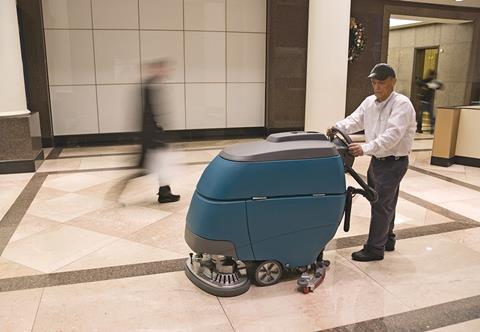
02 / Facilities Management and mobile assets
Mobile assets, as the name implies, are items that are not fixed within buildings but form part of delivering the operational requirement. They represent a diverse range of items from MRI scanners in laboratories to J cloths used in cleaning services.
A humble J cloth may not merit much attention in terms of the ability to reduce waste or cost; however when you consider that FM organisations consume millions of J cloths per year, investigating the resource stream becomes worthwhile.
This example is one of many, which is why the FM specialists at waste reduction body WRAP are working with a host of the UK’s leading FM providers to investigate the approach to the procurement and use of different items and equipment. This process has revealed there to be a clear requirement to consider the management of mobile assets, as these items can have a huge impact on cost, the environment and the reputation of an organisation.
The FM sector was estimated to be worth £127bn in 2013. FM providers are responsible for providing a host of services including cleaning, catering, horticulture, maintenance and many more.
They manage and deliver multimillion-pound contracts for an array of private and public sector clients. It is a highly competitive industry; hence the tendering process for winning new work (or maintaining existing contracts) is fraught with challenges.
Often when tendering for new work FM providers will have to estimate the quantity and condition of the mobile assets that are within the building or development. This presents a risk as the FM provider will not want to overprice its bid, nor will it want to rely on equipment of unknown quality or functionality.
To address this, many organisations will work on the basis that they need to buy all new equipment. This frequently leads to situations where incumbent FM providers are clearing out cupboards and loading up vans of equipment for disposal at the same time as the new FM provider is arriving and refilling the cupboards with the same (but brand new) items. Invariably, the old items end up being discarded.

03 / Developing a solution
As with many aspects of environmental performance, the key to driving change is to help organisations understand the financial implications of their current approach as opposed to a more sustainable one.
To facilitate this, WRAP has developed a range of toolkits that cover different FM sectors. These toolkits help the user to understand the implications of buying new equipment, rather than maintaining existing items or buying them reconditioned.
WRAP’s asset management models estimate the impacts of adopting good practices on:
- cost of mobile assets needed over the life of a contract
- mass of mobile assets used over the life of a contract
- mass of mobile assets disposed of over the life of a contract.
Model outputs are presented on a per m2 basis. Financial savings and costs are shown as a net present value (NPV), discounted at 3.5%. Carbon and waste that arise are not subject to a discount.
The impact of a resource-efficient approach to the management of mobile assets used in FM service delivery was assessed for cleaning and catering services. For each asset type, the following good practice options were considered:
- the lease or rent of assets if they are required infrequently and where there is little risk to the contract if they are not immediately available
- the use of redeployed assets, if available
- if buying new assets, the use of higher quality products to increase product life
- higher quality servicing and maintenance to increase product life
- options for the redeployment of assets at the end of their life.
The impacts of applying these measures would be to reduce the total quantity of assets needed to provide a given service (and the associated resource impacts), while also reducing the amount of waste generated.
The following charts look at the resource and cost savings available through deploying four different options:
- Purchasing “average” new assets, adopting high-quality servicing and scrapping all products at the end of the contract
- Purchasing “average” new assets, adopting high-quality servicing and redeploying assets at the end of the contract
- Using redeployed assets, adopting high-quality servicing and redeploying assets at the end of the contract
- Renting assets that are rarely used (average use is 1% of the year or less), and applying option 3 for more frequently used assets.
Figures 1-6 demonstrate some interesting findings, very much consistent with the ethos of a circular economy:
- For cleaning services, renting mobile assets offers the biggest cost and carbon benefits.
- For catering services, using redeployed assets (alongside high-quality servicing) offers the most advantages.
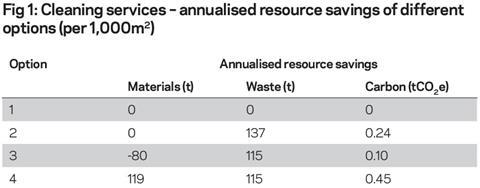
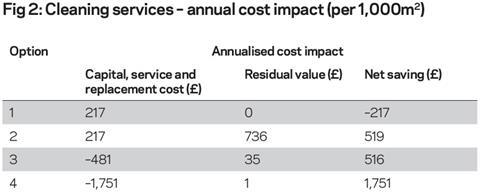
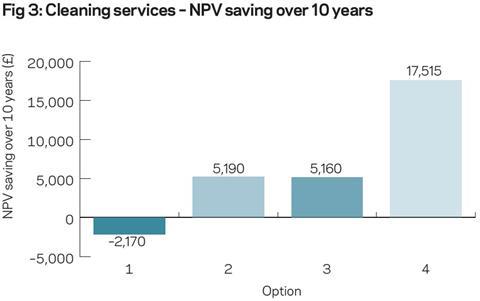
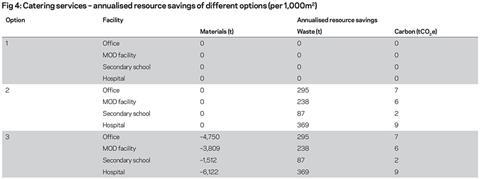
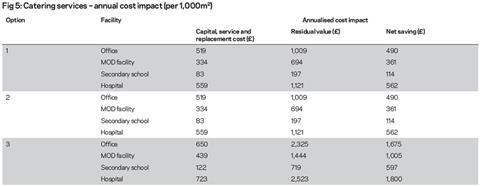
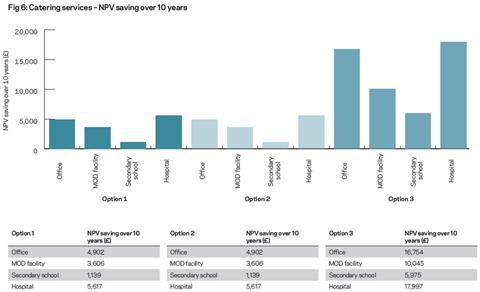
04 / Next steps
There are a variety of actions that FM professionals can take away from these findings. First and foremost, the ability to conduct the analysis is intrinsically linked to the quality of data available. Therefore, as a first step it is essential to actively and accurately manage and maintain data. This data needs to account for the condition of the assets managed.
The next step is to investigate how WRAP’s toolkits can influence financial decision-making (and potentially the tendering process). Considering assets from a lifecycle perspective may reveal that some “business as usual” options do not make for good business sense.
Further, a collaborative approach both internally and externally is vital for success. Estates and facilities managers should work alongside their sustainability colleagues and finance department to analyse the impact of their approach to mobile asset management (MAM) across the whole of their business activities.
Externally, FM professionals should work with their clients and their peers to standardise approaches and share data - this will lead to less waste and more benefit for everyone.
WRAP is in the process of developing guidance documents to help FM professionals and others to understand the MAM planning process in more depth and how they can apply it in practice. WRAP’s toolkits and guidance documents are in the public domain and free to use.
How does this fit in with other initiatives?
Initiatives such as Soft Landings emphasise the effective management of the transition from design to operation. The Soft Landings process focuses on the use of the building (for example, managing processes and the function of the equipment) and it is a much-needed and sensible initiative to reduce the gap between design and performance.
However, it doesn’t necessarily cover the long-term strategy for the procurement of the equipment used - that is, when to install new and when to maintain existing assets. MAM aligns with the ethos of Soft Landings by ensuring operational processes are cost effective through being resource efficient.
Another emerging discipline that works in concert with MAM is BIM. BIM’s strength is in helping the user to understand data and visualise the impact of their decisions. BIM models can be populated using the Construction Operations Building information exchange (COBie), which was designed to help organise data for new and existing facilities. Linking COBie with MAM data represents an effective way of combining these various initiatives and reaching the overall goal of improved operational performance.
Conclusion
As legislation dictates the design and construction of assets, the operational phase will represent a greater opportunity to improve performance and capture business benefits. FM providers have an increasingly pivotal role to play - the way they procure and use goods and equipment will become a crucial area of focus and a critical way of differentiating from competitors and demonstrating good value.
MAM is a key area for preventing waste and reducing costs through more effective purchasing and deployment decisions. It focuses attention on actions to conserve the value of assets owned by the FM service provider. It can also be offered to clients as a value-adding service for managing client-owned assets.
For further information, go to:




























No comments yet